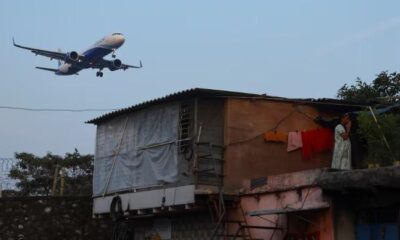Fashion
Dior names Greta Lee as brand ambassador

Published
September 12, 2025
Dior has named Greta Lee as its newest brand ambassador for the collections designed by Jonathan Anderson.
The American actress, acclaimed for her moving performance in Celine Song’s “Past Lives” and more recently in Kent Jones’ “Late Fame, has emerged as one of contemporary cinema’s most distinctive voices. Dior praised Lee’s “talent and instinctive elegance,” noting that this “inspiring new alliance resonates perfectly with the house’s ever-evolving creativity.”
Lee is the latest celebrity to be named a Dior ambassador since Anderson took the helm of the brand’s collections. Earlier this month, American actress Mikey Madison was announced in the same role, joining a roster of ambassadors that includes Anya Taylor-Joy, Jisoo, Anna Sawai, Camille Cottin, and Beatrice Borromeo.
The appointment highlights Anderson’s growing emphasis on connecting Dior to cinema. At this month’s Venice Film Festival, he dressed several stars — including Monica Barbaro, Alba Rohrwacher, and Mia Goth — in his first women’s designs for the house. Lee also appeared at the festival wearing multiple Dior looks.
Anderson joined Dior as creative director of women’s, men’s, and haute couture collections in late spring and presented his debut menswear show in Paris in June. His womenswear debut is set for October 1 during Paris Fashion Week.
Copyright © 2025 FashionNetwork.com All rights reserved.
Fashion
Louvre Museum closed as workers strike

By
AFP
Published
December 15, 2025
The Louvre Museum closed its doors to thousands of disappointed visitors on Monday as staff launched a strike to protest working conditions at the Paris landmark, two months after a shocking robbery.
Workers are demanding extra staff and measures to tackle overcrowding, adding to the woes of the world’s most visited museum just as France is gearing up for the Christmas holidays.
The strike comes nearly two months after the museum was victim of an embarrassing daylight heist that saw crown jewels worth $102 million stolen.
“We are closed,” a security agent told visitors on Monday morning, according to an AFP journalist. “Come back in a few hours.”
Around 400 employees voted unanimously to continue their strike at a general meeting, the CGT and CFDT unions said.
“I’m very disappointed, because the Louvre was the main reason for our visit in Paris, because we wanted to see the ‘Mona Lisa’,” said 37-year-old Minsoo Kim, who travelled from Seoul to Paris with his wife for their honeymoon.
Natalia Brown, a 28-year-old tourist from London, said she was also disappointed. “At the same time, I understand why they’re doing it, it’s just unfortunate timing for us.”
Speaking on the eve of the action, Christian Galani, from the hard-left CGT union, said the strike would have broad support across the museum’s 2,200-strong workforce.
“We’re going to have a lot more strikers than usual,” Galani said. “Normally, it’s front-of-house and security staff. This time, there are scientists, documentarians, collections managers, even curators and colleagues in the workshops telling us they plan to go on strike.”
All have different grievances, adding up to a picture of staff discontent inside the institution, just as it finds itself in a harsh public spotlight following the shocking robbery on October 19.
Reception and security staff complain they are understaffed and required to manage vast flows of people, with the home of Leonardo da Vinci’s “Mona Lisa” welcoming several million people beyond its planned capacity each year.
A spontaneous walk-out protest on June 16 this year led the museum to temporarily close.
The Louvre has become a symbol of so-called “over-tourism”, with the 30,000 daily visitors facing what unions call an “obstacle course” of hazards, long queues, and sub-standard toilets and catering.
Documentarians and curators are increasingly horrified by the state of disrepair inside the former royal palace, with a recent water leak and the closure of a gallery due to structural problems underlining the difficulties.
“The building is not in a good state,” chief Louvre architect Francois Chatillon admitted in front of lawmakers last month during a parliamentary hearing.
Under-fire Louvre boss Laurence des Cars, who faces persistent calls to resign, warned the government in January in a widely publicised memo about leaks, overheating and the declining visitor experience.
After the memo, French President Emmanuel Macron announced a massive renovation plan for the museum, expected to cost 700 million to 800 million euros (up to $940 million).
Questions continue to swirl since the break-in over whether it was avoidable and why a national treasure such as the Louvre appeared to be so poorly protected.
Two intruders used a portable extendable ladder to access the gallery containing the crown jewels, cutting through a glass door with angle grinders in front of startled visitors before stealing eight priceless items.
Investigations have since revealed that only one security camera was working outside when they struck, that guards in the control room did not have enough screens to watch the coverage in real time, and that police were initially misdirected.
Major security vulnerabilities were highlighted in several studies seen by management of the Louvre over the last decade, including a 2019 audit by experts at the jewellery company Van Cleef & Arpels.
Their findings stressed that the riverside balcony targeted by the thieves was a weak point and could be easily reached with an extendable ladder- exactly what transpired in the heist.
Copyright © 2025 AFP. All rights reserved. All information displayed in this section (dispatches, photographs, logos) are protected by intellectual property rights owned by Agence France-Presse. As a consequence you may not copy, reproduce, modify, transmit, publish, display or in any way commercially exploit any of the contents of this section without the prior written consent of Agence France-Presses.
Fashion
Gauthier Borsarello announces his departure from Fursac

Published
December 15, 2025
Under Gauthier Borsarello’s creative direction, Fursac joined the Paris Fashion Week calendar. Over five years at the creative helm of the French menswear brand, the designer remained faithful to the label’s formal roots while setting a new tone.
Under the leadership of the vintage specialist and co-founder of L’étiquette magazine, the brand, which was still called De Fursac when he arrived and had just been taken over by the SMCP group, staged its first presentation for the spring/ summer 2023 season. Last January, Borsarello staged a catwalk show to present his vision for autumn/ winter 2025-2026. In mid-December, he announced his departure via his Instagram account.
“I would like to sincerely thank Daniel Lalonde, Elina Kousourna, Alix Le Naour, Evelyne Chetrite, and Judith Milgrom for the opportunity to work at Fursac five years ago as creative director. This chapter has been meaningful, both creatively and professionally. I am grateful for the trust, the exchanges, and the freedom to contribute to the evolution of the brand,” he says in a message dated December 12.
“I am particularly proud of the studio, design, image, and communications, and of what we have achieved together: bringing the brand onto the official Fashion Week calendar after just one season, and continuing this journey through to the Paris Fashion Week show in January 2025. Thank you for the experience, perspective, and relationships built along the way. I will carry them with me on my journey.”
In five years, the designer has introduced modernised silhouettes and strengthened Fursac’s casual wardrobe, with a heightened focus on fabric choices. He has also broadened his references, from inspirations drawn from football and surfing to a more cutting-edge creative universe centred on music and the arts, as in his SS25 presentation through work with artist Lionel Estève, whose work is exhibited at the Musée Picasso in Paris.
The group confirmed this decision to FashionNetwork.com. “The group’s studio teams have taken over and are currently working on finalising the FW 2026 collection,” notes Isabelle Guichot, SMCP’s chief executive.
The brand welcomed Louise Bousquet-Andreani as its managing director at the beginning of the year. For the time being, activity at its historic premises and boutique on the corner of Richelieu-Drouot, on the Grands Boulevards in Paris, has been put on hold, FashionNetwork observed.
“The Fursac teams at the rue Richelieu boutique have been temporarily redeployed to the brand’s other Parisian stores, notably for the end-of-year sales period. SMCP hopes to reopen the rue Richelieu boutique at the beginning of 2026”, explains Isabelle Guichot, who adds that “as part of the change of ownership of the building, SMCP has decided to bring Fursac’s head office teams into its offices in the 1st arrondissement of Paris.”
Along with Claudie Pierlot, Fursac is reported under the group’s Other Brands segment in SMCP’s published results. After revenue reached €167 million in 2023, this division declined to €148 million in 2024. In the first nine months of 2025, sales were stable compared with the previous year at €108 million, on group revenue of €895 million.
Following the completion of legal proceedings regarding the actions of its former shareholder, the group’s current majority shareholders announced their intention to sell their shares on November 27.
This article is an automatic translation.
Click here to read the original article.
Copyright © 2025 FashionNetwork.com All rights reserved.
Fashion
Higher festive spend is due to inflation, clothing among first to be cut for budgeters – Deloitte survey

Published
December 15, 2025
On the face of it, around a third of UK consumers planning to spend more this Christmas can only be positive, right? Alas, many are blaming higher prices for the decision, according to new Deloitte research.
If it’s any consolation, this is higher than the rest of Europe, where just 23% plan to spend more. And at least in the UK, consumers aged 18-34 are nearly twice as likely to spend more this Christmas compared with older age groups while almost half (44%) agree they have enough money “to create a joyful Christmas for themselves and their family this year”.
And while a third of those spending more are blaming higher prices, 23% say it’s a deliberate choice to allocate more budget to Christmas while 20% say they’re spending more because their financial situation has improved.
On the downside, 18% of UK consumers plan to spend less this Christmas compared with last year with around half (48%) blaming the cost of living, while 37% say it is because their financial situation has worsened.
Unfortunately, when asked about what they will cut back on if budgets becomes too constrained, the top things consumers stated were “experiences (restaurants or attending events)… and clothing. At least fewer are likely to cut back on gift vouchers, it noted.
Cande Cooper, retail partner at Deloitte UK, said: “While there is a strong desire among many UK consumers to create and spread joy this Christmas, shoppers are demonstrating a pragmatic approach, carefully balancing their budgets with their festive aspirations.
“High costs continue to squeeze many consumers’ spend, and so retailers will look to target consumers with promotions, whilst also catering to those looking for quality products and shopping experiences. Retailers should also take note of evolving consumer behaviours, particularly the increasing influence and adoption of GenAI in the shopping process.”
Copyright © 2025 FashionNetwork.com All rights reserved.
-

 Politics1 week ago
Politics1 week agoThailand launches air strikes against Cambodian military: army
-

 Fashion1 week ago
Fashion1 week agoGermany’s LuxExperience appoints Francis Belin as new CEO of Mytheresa
-

 Politics1 week ago
Politics1 week agoZelenskiy says Ukraine’s peace talks with US constructive but not easy
-

 Politics5 days ago
Politics5 days agoTrump launches gold card programme for expedited visas with a $1m price tag
-

 Politics1 week ago
Politics1 week ago17 found dead in migrant vessel off Crete: coastguard
-

 Tech6 days ago
Tech6 days agoJennifer Lewis ScD ’91: “Can we make tissues that are made from you, for you?”
-

 Business5 days ago
Business5 days agoRivian turns to AI, autonomy to woo investors as EV sales stall
-

 Entertainment1 week ago
Entertainment1 week agoToo big to fail? IndiGo crisis exposes risks in Indian aviation


















